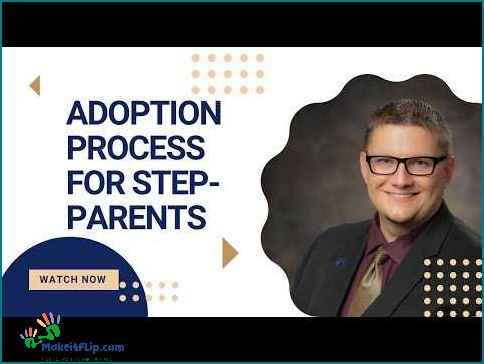Contents
- 1 Understanding the Process and Legal Requirements of Stepparent Adoption
- 1.1 The Adoption Process
- 1.2 Legal Requirements
- 1.3 FAQ about topic Stepparent Adoption The Process and Legal Requirements
- 1.3.1 What is stepparent adoption?
- 1.3.2 What are the legal requirements for stepparent adoption?
- 1.3.3 What is the process of stepparent adoption?
- 1.3.4 Can the child’s other biological parent object to the stepparent adoption?
- 1.3.5 What are the benefits of stepparent adoption?
- 1.3.6 What is stepparent adoption?
- 1.3.7 What are the legal requirements for stepparent adoption?
Understanding the Process and Legal Requirements of Stepparent Adoption

Adoption is a legal process that allows a stepparent to become the legal parent of their spouse’s child. This type of adoption is a significant step in solidifying the bond between a stepparent and their stepchild, creating a legally recognized family unit.
The stepparent adoption process involves several important steps. First, the stepparent must establish a strong relationship with the child, building trust and a sense of security. This relationship is crucial in demonstrating to the court that the adoption is in the best interest of the child.
Once the stepparent and child have developed a solid relationship, the next step is to navigate the legal requirements. These requirements vary by jurisdiction, but typically involve filing a petition with the court, obtaining consent from the noncustodial parent, and completing a home study to assess the stepparent’s suitability as a parent.
The final step in the stepparent adoption process is appearing before a judge in court. The judge will review the case and determine if the adoption is in the best interest of the child. If approved, the court will issue a final decree of adoption, legally recognizing the stepparent as the child’s parent.
Stepparent adoption is a complex legal process that requires careful attention to detail and adherence to the specific requirements of the court. However, the end result is a legally recognized family unit, providing the stepparent and child with the security and stability they deserve.
The Adoption Process
The legal process of stepparent adoption is a significant step in solidifying the bond between a stepparent and their stepchild. It involves various steps and requirements to ensure the best interests of the child and the stability of the new family unit.
The first step in the adoption process is for the stepparent to express their desire to adopt the child to the family court. This typically involves filing a petition for adoption, which outlines the reasons for the adoption and provides information about the stepparent’s relationship with the child.
Once the petition is filed, the court will review the case and determine if the adoption is in the best interests of the child. This may involve conducting a home study, where a social worker visits the stepparent’s home to assess their suitability as a parent and the overall environment in which the child will be raised.
If the court determines that the adoption is in the best interests of the child, it will schedule a hearing. During the hearing, the stepparent and the child’s other biological parent may be required to appear before the judge and provide testimony. The judge will consider all the evidence presented and make a final decision on whether to grant the adoption.
If the adoption is approved, the legal relationship between the stepparent and the child is established. The stepparent will have all the rights and responsibilities of a biological parent, including the ability to make decisions regarding the child’s education, healthcare, and general welfare.
It’s important to note that the adoption process can vary depending on the jurisdiction and individual circumstances. Consulting with an attorney who specializes in family law and adoption is highly recommended to navigate the legal requirements and ensure a smooth process.
Petition for Adoption

The petition for adoption is a crucial step in the process of stepparent adoption. It is the legal document that initiates the adoption proceedings and formally requests the court to grant the stepparent the right to adopt the child.
When filing the petition, the stepparent must provide detailed information about themselves, the child, and their relationship with the child. This includes their full name, address, and contact information, as well as the child’s full name, date of birth, and current living arrangements.
The petition also requires the stepparent to explain the nature of their relationship with the child and provide evidence of their commitment to the child’s well-being and upbringing. This can include details about their involvement in the child’s daily life, financial support, and emotional support.
Additionally, the stepparent must demonstrate that the child’s legal parent is willing to terminate their parental rights and consent to the adoption. This typically involves obtaining the legal parent’s consent through a separate document or court order.
Once the petition is filed with the court, a hearing will be scheduled to review the case. During the hearing, the court will consider the best interests of the child and evaluate the stepparent’s suitability as an adoptive parent. The court may also request additional documentation or conduct interviews with the stepparent, child, and other relevant parties.
If the court determines that the adoption is in the best interests of the child and that the stepparent meets all legal requirements, they will issue an adoption decree. This decree legally establishes the stepparent as the child’s parent and grants them all the rights and responsibilities associated with parenthood.
Overall, the petition for adoption is a critical step in the stepparent adoption process. It allows the court to assess the stepparent’s suitability as an adoptive parent and ensures that the child’s best interests are protected. By following the necessary legal procedures and providing the required documentation, the stepparent can successfully navigate the adoption process and create a legally recognized and loving family.
Home Study

A home study is a crucial step in the stepparent adoption process. It is a comprehensive evaluation conducted by a licensed social worker or adoption agency to assess the suitability of the prospective stepparent and their home environment for the child. The purpose of the home study is to ensure that the child’s best interests are protected and that the stepparent is capable of providing a stable and nurturing environment.
During the home study, the social worker or adoption agency will conduct interviews with the stepparent, the child, and other members of the household. They will also visit the home to assess its safety and suitability for the child. The social worker will gather information about the stepparent’s background, including their relationship with the child and their ability to meet the child’s emotional, physical, and financial needs.
The home study process also involves a thorough review of the stepparent’s criminal background, child abuse and neglect registry checks, and personal references. The social worker will also request medical records and financial information to ensure that the stepparent is capable of providing for the child’s needs.
Once the home study is completed, the social worker will prepare a written report that includes their findings and recommendations. This report will be submitted to the court as part of the stepparent adoption petition. The court will review the home study report along with other legal requirements to determine if the adoption is in the best interests of the child.
It is important to note that the home study process can vary depending on the state and the specific circumstances of the adoption. However, the overall goal remains the same – to ensure that the child will be placed in a safe and loving home with a capable and committed stepparent.
Consent of Biological Parent

In the process of stepparent adoption, obtaining the consent of the biological parent is a crucial step. The court requires the consent of the biological parent before granting the adoption. This consent is necessary to ensure that the best interests of the child are protected and that the legal rights of all parties involved are respected.
The consent of the biological parent signifies their agreement to terminate their parental rights and responsibilities towards the child. It acknowledges that the stepparent adoption will establish a new legal parent-child relationship between the child and the stepparent.
The legal requirements for obtaining the consent of the biological parent may vary depending on the jurisdiction. In some cases, the biological parent may need to appear in court and provide their consent in person. In other cases, they may be required to sign a written consent form in the presence of a witness or notary public.
It is important to note that the court may waive the requirement for the biological parent’s consent in certain circumstances. For example, if the biological parent has abandoned the child or has had their parental rights terminated due to abuse or neglect, their consent may not be necessary.
Obtaining the consent of the biological parent can be a sensitive and emotional process. It is important to approach this step with empathy and understanding, as it may involve complex family dynamics and relationships. Open communication and transparency can help facilitate the consent process and ensure that all parties involved are aware of their rights and responsibilities.
| Key Points |
|---|
| The consent of the biological parent is required in the process of stepparent adoption. |
| The consent signifies the agreement to terminate parental rights and establish a new legal parent-child relationship. |
| The legal requirements for obtaining consent may vary depending on the jurisdiction. |
| The court may waive the requirement for consent in certain circumstances. |
| Open communication and empathy are important in the consent process. |
Legal Requirements
The process of stepparent adoption involves going through the court system to legally establish a parent-child relationship between the stepparent and the child. This process is subject to certain legal requirements that must be met in order for the adoption to be granted.
One of the main legal requirements for stepparent adoption is the consent of both biological parents. The noncustodial parent must give up their parental rights and consent to the adoption. This is typically done through a legal document known as a consent form.
In addition to obtaining consent from the noncustodial parent, the stepparent must also meet other legal requirements. These may include being married to the custodial parent for a certain period of time, having a stable and loving relationship with the child, and being able to provide for the child’s needs.
The court will also consider the best interests of the child when deciding whether to grant the adoption. This may involve conducting a home study to assess the suitability of the stepparent and their home environment. The court will also take into account the child’s wishes, if they are old enough to express them.
Once all the legal requirements have been met, the court will issue an adoption decree, legally establishing the stepparent as the child’s parent. This creates a new legal relationship within the family and provides the stepparent with the same rights and responsibilities as a biological parent.
Overall, the legal requirements for stepparent adoption are in place to ensure that the adoption process is carried out in the best interests of the child and to protect the rights of all parties involved.
FAQ about topic Stepparent Adoption The Process and Legal Requirements
What is stepparent adoption?
Stepparent adoption is the legal process in which a stepparent becomes the legal parent of his or her spouse’s child. This process allows the stepparent to assume all the legal rights and responsibilities of a biological parent.
What are the legal requirements for stepparent adoption?
The legal requirements for stepparent adoption vary depending on the jurisdiction, but generally, the stepparent must be married to the child’s biological parent, have the consent of the child’s other biological parent, and meet certain age and residency requirements.
What is the process of stepparent adoption?
The process of stepparent adoption typically involves filing a petition with the court, obtaining consent from the child’s other biological parent, undergoing a home study evaluation, attending a court hearing, and obtaining a new birth certificate for the child with the stepparent’s name listed as a parent.
Can the child’s other biological parent object to the stepparent adoption?
Yes, the child’s other biological parent can object to the stepparent adoption. However, their objection may not prevent the adoption from taking place if the court determines that the adoption is in the best interests of the child.
What are the benefits of stepparent adoption?
Stepparent adoption can provide numerous benefits for both the child and the stepparent. For the child, it can provide a sense of stability, security, and a legal connection to their stepparent. For the stepparent, it can allow them to fully assume the role of a parent and make important decisions regarding the child’s upbringing.
What is stepparent adoption?
Stepparent adoption is the legal process of a stepparent becoming the legal parent of their spouse’s child. It allows the stepparent to assume all the rights and responsibilities of a biological parent.
What are the legal requirements for stepparent adoption?
The legal requirements for stepparent adoption vary by jurisdiction, but generally include obtaining consent from the biological parent, terminating the parental rights of the noncustodial parent, and completing a home study. It is important to consult with an attorney to understand the specific requirements in your area.
I’m Diana Ricciardi, the author behind Makeitflip.com. My blog is a dedicated space for mothers and their kids, where I share valuable insights, tips, and information to make parenting a bit easier and more enjoyable.
From finding the best booster seat high chair for your child, understanding the connection between sciatica and hip pain, to exploring the benefits of pooping in relieving acid reflux, I cover a range of topics that are essential for every parent.
My goal is to provide you with practical advice and solutions that you can easily incorporate into your daily life, ensuring that you and your child have the best possible experience during these precious years.
